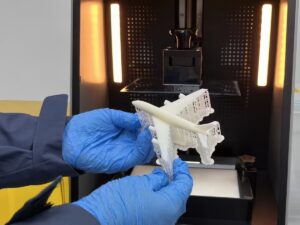- SLS 3D Printed Cylindrical Enclosure Electronics Housing Made with Formlabs Nylon PA 12
- MJF 3D Printed League of Legends Seraphine Gaming Mouse Full-color Nylon Shell
Gallery
About Project
Are you looking for a strong and durable material for your 3D-printed parts? If so, you might want to check out our flanged housing made with Formlabs Nylon PA 12 and SLS 3D printing technology.
Formlabs Nylon PA 12 is a versatile prototyping material that offers high dimensional accuracy and low creep. It can be printed with up to 70% recycled powder, making it an economical choice for your projects.
SLS (Selective Laser Sintering) is a powder-based 3D printing technology that uses a laser to fuse material layers into a final part. It can create complex geometries and functional parts without the need for supports.
Our flanged housing has a triangular shape and three cylindrical bores. It is designed to fit snugly and securely on your equipment. It can withstand high temperatures and mechanical stress.
If you are interested in our nylon 3D printing service, please visit our website or contact us today. We offer fast turnaround times, competitive prices, and high-quality results. FacFox is your trusted partner for all your 3D printing needs.
Solution
- Step 1: First, the 3D model was broken down into layers of 0.1 mm on the computer and adjusted for better positioning. The model was then duplicated and piled according to the required amount.
- Step 2: Before printing, the tank would be filled with SLS Grey Nylon PA12 powders. On a bed pressure, a 0.1 mm thick layer over the whole width was applied.
- Step 3: The machine was preheated to above 100┬░C, and the laser would light the powder and increase the temperature just above the melting point of the powders.
- Step 4: After a layer was formed, the platform would lower down and produce another layer until the whole model got produced.
- Step 5: When the printing process ended, excess powders which also served as supports would be removed with brushes and a vacuum cleaner.







